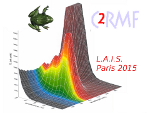The Clermont TL-dating group practices routinely the quartz-inclusion technique with an additive + regeneration protocol (see, e.g., Bassinet et al., 2006). Since the dose-response curves of quartz are not simple, that is neither linear nor saturating-exponential, several different dose-points are needed for reconstructing these curves. Also, because the TL of quartz is usually scattered, it is necessary to measure several distinct aliquots for getting an acceptable uncertainty on a single dose point. For example, an additive dose-response curve will be plotted with a minimum of 5 different added doses, plus the zero-one (i.e., the natural TL), with 15 aliquots per dose. This leads to 90 distinct measurements at least. It is highly time-consuming, all the more since two dose-response curves have to be constructed for one dating. Because no commercially available TL-reader had enough positions for 90 samples when we began this program, we decided to build a specially designed one, with 100 positions. We also took this opportunity to imagine a system which would not need disks, so as to avoid a complementary source of scattering of the TL curves, due to the variation of thermal contacts with the heating element for individual disks.
Our protocol allows avoiding two usual requirements for TL-sets: the aliquots are not re-used after measurement and we do not need beta irradiation. Actually, the samples are routinely irradiated with a gamma source, by batches of about 200 mg and measured long after irradiation, i.e., at least several months. This routine is intended at allowing the unstable components of TL to vanish. This is because, like other authors (e.g., Smith and Prescott, 1984) we have observed that the scattering of the TL curves has a tendency to diminish with the time elapsed after irradiation.
The mechanical system was built with the following principles. The sample holder is a carousel carrying 100 glass tubes (L: 25 mm; f: 5 mm) individually able to move around a horizontal pin. These tubes are intended at keeping the different aliquots of grains before they are poured on the heating element - a blade of titanium, 1 cm wide - by mechanical dumping of the tubes. A mobile centering ring allows a uniform spreading of the grains on the surface of the blade. The aliquots are prepared as for a manual TL-set, with a calibrated container which typically selects ~ 9 mg of grains in the range 200-300 mm. The photomultiplier tube is moved away during the phase of emplacement of the grains on the heating element. After measurements, the grains are eliminated from the heating element and evacuated toward a unique reservoir by a combination of air-pumping and vacuum-breaking.
The thermal regulation system is classic. It enables any programmable heating rate between 0°C/s and 20°C/s and any heating and pre-heating sequence. Interchangeable optical filters are fixed on the mobile photomultiplier holder and cannot be changed during the course of a measurement series.
Tests of reproducibility and stability were performed before a routine application.
Aknowledgements:
The system was designed and made in the technical department of the Laboratoire de Physique Corpusculaire de Clermont-Ferrand and especially by C. Crozatier (mechanics), D. Lambert and R. Chadelas (automation and regulation) and E. Delage (soft interface).
References:
Bassinet, C., Mercier, N., Miallier, D., Pilleyre, T., Sanzelle, S., Valladas, H. (2006) Thermoluminescence of heated quartz grains: intercomparisons between SAR and multiple aliquot additive dose techniques . Radiat. Measurements 41, 7-8, 803-808.
Smith, B. and Prescott, J.-R. (1984) A cautionary note on the measurement of quartz TL immediately after irradiation. Ancient TL 2, 2, 14-18.

 PDF version
PDF version
